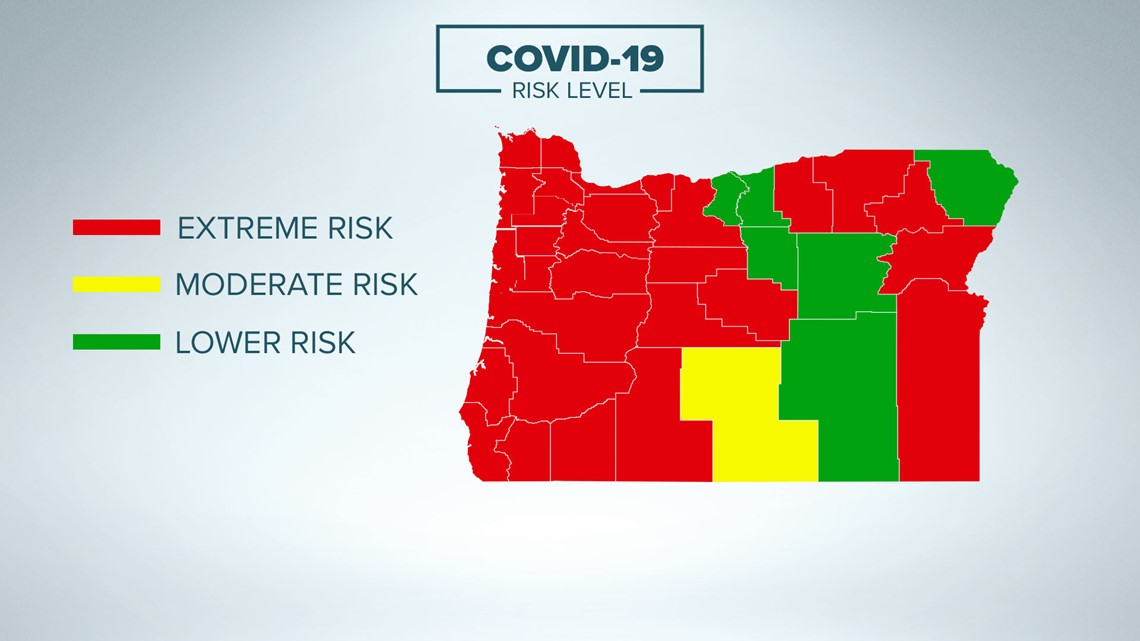PORTLAND, Ore — Oregon Gov. Kate Brown on Tuesday announced updates to each county’s COVID-19 risk level, which dictates what restrictions will be in place beginning Friday, Dec. 18.
There will be 29 counties in the Extreme Risk level, zero counties in the High Risk level, one county at Moderate Risk and six counties at Lower Risk.
Six counties (Benton, Clatsop, Coos, Curry, Lincoln and Tillamook) have been added to the Extreme Risk category since the first risk level map was released two weeks ago. Two counties (Grant and Lake) were removed from the Extreme Risk category.
“We continue to see community spread across Oregon to the point that the majority of the state needs to continue with strict health and safety measures,” said Governor Brown. “Until we reduce the spread and have high participation in vaccination, all Oregonians need to follow the guidelines in place in their counties.”
Here’s the full list of county risk levels.
Extreme risk (29 counties):
- Baker
- Benton (moved from High)
- Clackamas
- Clatsop (moved from High)
- Columbia
- Coos (moved from High)
- Crook
- Curry (moved from High)
- Deschutes
- Douglas
- Hood River
- Jackson
- Jefferson
- Josephine
- Klamath
- Lane
- Lincoln (moved from High)
- Linn
- Malheur
- Marion
- Morrow
- Multnomah
- Polk
- Tillamook (moved from Moderate)
- Umatilla
- Union
- Wasco
- Washington
- Yamhill
High risk (0 counties)
Moderate risk (1 county):
- Lake (moved from Extreme)
Lower risk (6 counties):
- Gilliam
- Grant (moved from Extreme)
- Harney (moved from Moderate)
- Sherman
- Wallowa
- Wheeler


Counties will remain at these risk levels from Dec. 18 to Dec. 31. The Oregon Health Authority will reassign county risk levels every two weeks based on the most recent coronavirus data available.
Here's a look at which metrics determine the risk level for each county:
In counties with extreme risk, the following activities will be allowed, with health and safety protocols in place:
- Social and at-home gatherings with people from outside your household will be limited to a maximum of six people, with a recommended limit of two households.
- Restaurants, bars, and other eating and drinking establishments will be limited to a maximum of 50 people for outdoor dining only, with only six people per table. Take-out is strongly encouraged.
- Indoor recreation, fitness, and entertainment establishments, including gyms, will remain closed, however, outdoor recreation, fitness, and entertainment activities, including outdoor gym activities, will be allowed, with a maximum limit of 50 people outdoors.
- Retail stores, grocery stores, pharmacies, and indoor and outdoor shopping centers and malls will be limited to a maximum of 50% of capacity, with curbside pick-up encouraged.
- Faith institutions, funeral homes, mortuaries, and cemeteries will be limited to a maximum of 25% of capacity or 100 people indoors (whichever is smaller), or 150 people outdoors.
- Office workplaces will be required to utilize remote work to the maximum extent possible, with public-facing offices closed to the public.
- Personal services businesses will be allowed to continue to operate with health and safety measures in place.
- Long-term care facilities can allow limited outdoor visitation, following established health and safety protocols.
Here's a look at what activities will be offered under each risk category:

